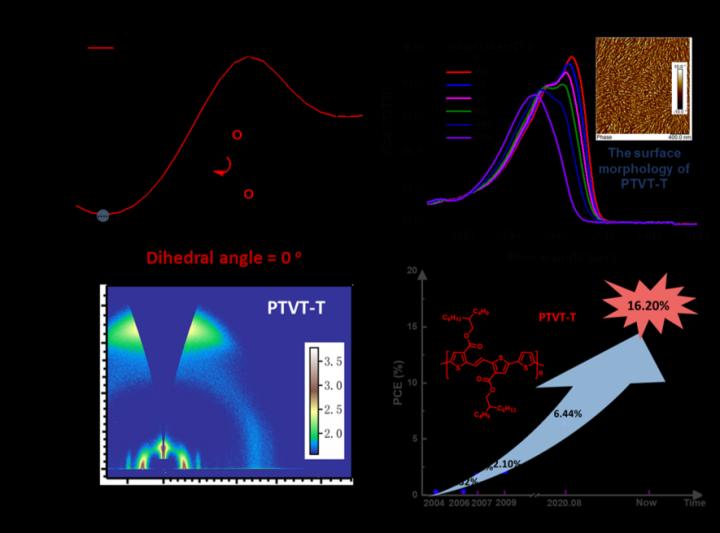
Credit: @Science China Press
Organic solar cell (OSC) is one of the most important green energy technologies. The photovoltaic efficiencies of OSCs are closely related to the photoactive layers, which are prepared by blending electron donor and acceptor materials. With the emergence of a large number of new organic photovoltaic materials and effective molecular modification methods, the photovoltaic efficiency of OSCs has been greatly improved. Accordingly, the molecular structure of the materials is becoming much more complex with high costs, which is difficult to meet the requirements of the industrialization of OSCs. Thus, it is of great importance to develop novel photovoltaic materials with low-cost and high performance simultaneously.
Some classical conjugated polymers (such as polythiophenes, polythienylene vinylenes, polyphenylene vinylenes, etc.) in the early stage of organic photovoltaic field have simple molecular structure and great cost advantage, which play important roles in the early research of OSCs. However, the classical conjugated polymers have gradually faded out of high efficiency OSCs due to the problem that “the aggregation state and molecular energy level cannot match well with the new non-fullerene-acceptors”. Therefore, can we explore an effective molecular design strategy, which could revitalize the classic low-cost polymers with high photovoltaic performance?
Recently, the National Science Review (NSR) online published the latest research work of the research group of Professor Zhang Shaoqing of University of science and technology, Beijing and the research group of Hou Jianhui of Institute of chemistry of Chinese Academy of Sciences. Based on the classic backbone of poly(thienylene vinylene) (PTV), an ester substituted PTV derivative, PTVT-T, was designed and prepared in very few steps. A remarkable photovoltaic efficiency of 16.2% was then realized by using PTVT-T as donor material.
The key point of the molecular design strategy is that the symmetrical diester groups were introduced in the repeated segments of PTVT-T, which enable its significant aggregation effect in solution state and the molecular energy level of PTVT-T can be modulated synergistically.
In the repeat unit of PTVT-T, the introduction of the symmetrical ester substituents makes the polymer have a more stable planar conformation, which leads to a significant “aggregation effect in solution state”. As a result, nano scale phase separation morphology can be easily formed in the active layer. Low-lying Homo level is also important for designing new polymer donor materials, which enables high output voltage in the corresponding OSCs. The diester groups in PTVT-T exhibits significant electron withdrawing properties, which reduces its HOMO energy level to – 5.28 eV.
The outstanding advantages of PTVT-T are: (a) the low-cost feature enabled by the very simple chemical structure and synthesis method; (b) matched photoelectronic properties with three typical acceptor materials; (c) the corresponding OSCs have high performance and good stability.
PTVT-T show simple chemical structure and does not contain the F atom, which are commonly used in other highly efficient polymer donors. Therefore, the synthesis steps and the costs of PTVT-T are significantly lower than those of the polymers with state-of-the-art efficiencies. PTVT-T can work well with the representative acceptors, PCBM, IT-4F and eC9, showing great potential to match with new emerging acceptor materials.
Particularly, a remarkable efficiency of 16.20% can be realized by blending PTVT-T with the acceptor eC9, and the corresponding devices show good stability, i.e., the cells can maintain over 80% of the initial efficiency after continuous illumination of AM 1.5G for about 500 hours.
This work demonstrated that the conjugated polymers with simple chemical structure, especially for the classical polymers developed in the early stage of OSC, will be revitalized by rational molecular design method and realize highly efficient OSC with low-cost feature.
###
The study was published in National Science Review with the title of “Molecular design revitalizes the low cost PTV polymer for high efficiency organic solar cells”. Ren Junzhen, a laboratory technician of University of science and technology, Beijing and Institute of chemistry of Chinese Academy of Sciences, is the first author of the research article. Professor Zhang Shaoqing and Professor Hou Jianhui are the corresponding authors.
See the article:
Junzhen Ren, Pengqing Bi, Jianqi Zhang, Jiao Liu, Jingwen Wang, Ye Xu, Zhixiang Wei, Shaoqing Zhang, and Jianhui Hou
Molecular design revitalizes the low-cost PTV-polymer for highly efficient organic solar cells
Natl Sci Rev
https:/
The National Science Review is the first comprehensive scholarly journal released in English in China that is aimed at linking the country’s rapidly advancing community of scientists with the global frontiers of science and technology. The journal also aims to shine a worldwide spotlight on scientific research advances across China.
Media Contact
Shaoqing Zhang
[email protected]
Original Source
http://doi.
Related Journal Article
http://dx.




